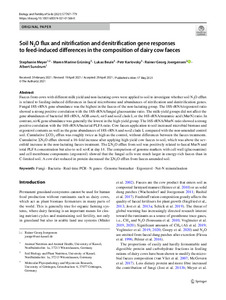| dc.date.accessioned | 2021-09-01T13:12:33Z | |
| dc.date.available | 2021-09-01T13:12:33Z | |
| dc.date.issued | 2021-05-17 | |
| dc.identifier | doi:10.17170/kobra-202107264404 | |
| dc.identifier.uri | http://hdl.handle.net/123456789/13199 | |
| dc.description.sponsorship | Gefördert im Rahmen des Projekts DEAL | ger |
| dc.language.iso | eng | eng |
| dc.rights | Namensnennung 4.0 International | * |
| dc.rights.uri | http://creativecommons.org/licenses/by/4.0/ | * |
| dc.subject | fungi | eng |
| dc.subject | bacteria | eng |
| dc.subject | real-time PCR | eng |
| dc.subject | N genes | eng |
| dc.subject | genome biomarker | eng |
| dc.subject | ergosterol | eng |
| dc.subject | net-N mineralisation | eng |
| dc.subject.ddc | 570 | |
| dc.subject.ddc | 630 | |
| dc.title | Soil N₂O flux and nitrification and denitrification gene responses to feed-induced differences in the composition of dairy cow faeces | eng |
| dc.type | Aufsatz | |
| dcterms.abstract | Faeces from cows with different milk yield and non-lactating cows were applied to soil to investigate whether soil N₂O efflux is related to feeding-induced differences in faecal microbiome and abundances of nitrification and denitrification genes. Fungal 18S-rRNA gene abundance was the highest in the faeces of the non-lactating group. The 18S-rRNA/ergosterol ratio showed a strong positive correlation with the 18S-rRNA/fungal glucosamine ratio. The milk-yield groups did not affect the gene abundances of bacterial 16S rRNA, AOB amoA, nirS and nosZ clade I, or the 16S-rRNA/muramic acid (MurN) ratio. In contrast, nirK gene abundance was generally the lowest in the high-yield group. The 16S-rRNA/MurN ratio showed a strong positive correlation with the 16S-rRNA/bacterial PLFA ratio. Cow faeces application to soil increased microbial biomass and ergosterol contents as well as the gene abundances of 18S-rRNA and nosZ clade I, compared with the non-amended control soil. Cumulative ΣCO₂ efflux was roughly twice as high as the control, without differences between the faeces treatments. Cumulative ΣN₂O efflux showed a 16-fold increase after applying high-yield cow faeces to soil, which was above the sevenfold increase in the non-lactating faeces treatment. The ΣN₂O efflux from soil was positively related to faecal MurN and total PLFA concentration but also to soil nirK at day 14. The comparison of genome markers with cell wall (glucosamine) and cell membrane components (ergosterol) showed that the fungal cells were much larger in energy-rich faeces than in C-limited soil. A cow diet reduced in protein decreased the ΣN₂O efflux from faeces amended soil. | eng |
| dcterms.accessRights | open access | |
| dcterms.creator | Meyer, Stephanie | |
| dcterms.creator | Grüning, Maren Marine | |
| dcterms.creator | Beule, Lukas | |
| dcterms.creator | Karlovsky, Petr | |
| dcterms.creator | Jörgensen, Rainer Georg | |
| dcterms.creator | Sundrum, Albert | |
| dc.relation.doi | doi:10.1007/s00374-021-01566-0 | |
| dc.subject.swd | Pilze | ger |
| dc.subject.swd | Bakterien | ger |
| dc.subject.swd | Real time quantitative PCR | ger |
| dc.subject.swd | Gen | ger |
| dc.subject.swd | Biomarker | ger |
| dc.subject.swd | Ergosterin | ger |
| dc.subject.swd | Stickstoffverbindungen | ger |
| dc.subject.swd | Mineralisation | ger |
| dc.type.version | publishedVersion | |
| dcterms.source.identifier | eissn:1432-0789 | |
| dcterms.source.issue | Issue 6 | |
| dcterms.source.journal | Biology and Fertility of Soils | eng |
| dcterms.source.pageinfo | 767-779 | |
| dcterms.source.volume | Volume 57 | |
| kup.iskup | false | |


